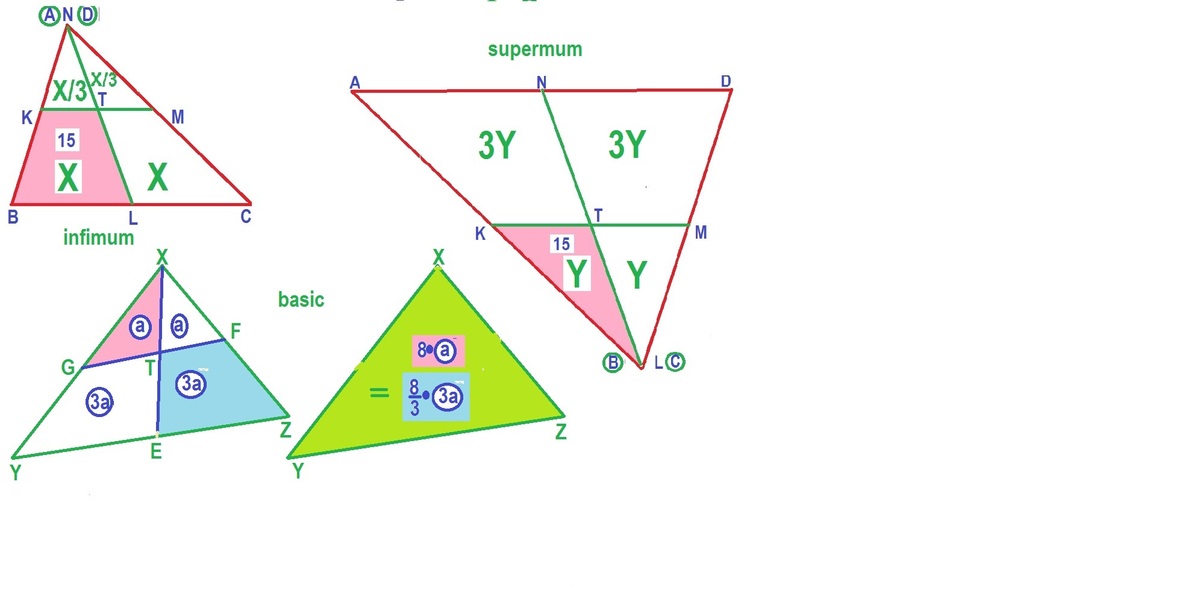Apply Midpoint Theorem?
Let be a convex quadrilateral, and let the midpoints of , , and be , , and . Let intersect at . If the area of is 15, find the sum of the infimum and the supremum areas of .
The answer is 160.
This section requires Javascript.
You are seeing this because something didn't load right. We suggest you, (a) try
refreshing the page, (b) enabling javascript if it is disabled on your browser and,
finally, (c)
loading the
non-javascript version of this page
. We're sorry about the hassle.

We will create a bound for ∣ A B C D ∣ in terms of ∣ B K T L ∣ .
We will first find a lower bound.
By Midpoint Theorem, K L ∥ A C ∥ M N and K N ∥ B D ∥ L M . Thus, K L M N is a parallelogram and ∣ K L T ∣ = ∣ L M T ∣ = ∣ M N T ∣ = ∣ N T K ∣ = 4 1 ∣ K L M N ∣ . Also, since K and N are the midpoints of A B and D A , the length of the perpendicular dropped from A to K N is the same as the length of the perpendicular from a point on K N on to B D . The same applies for the other 3 points. Thus, ∣ A K N ∣ + ∣ B K L ∣ + ∣ C L M ∣ + ∣ D M N ∣ = ∣ K L M N ∣ , which implies ∣ K L T ∣ = 8 1 ∣ A B C D ∣ .
By similarity, we have ∣ B K L ∣ = 4 1 ∣ B C A ∣ . We also know that ∣ B C A ∣ < ∣ A B C D ∣ since the quadrilateral is convex and we also know that ∣ B C A ∣ + ϵ ≤ ∣ A B C D ∣ for any small ϵ > 0 . Thus, ∣ B K L ∣ < 4 1 ∣ A B C D ∣ .
From this, we get ∣ K L T ∣ + ∣ B K L ∣ < 8 1 ∣ A B C D ∣ + 4 1 ∣ A B C D ∣ , which implies 3 8 ∣ B K T L ∣ < ∣ A B C D ∣ . Note that this is the tightest lowest bound since the strictly less than case becomes less than or equal to for any sufficiently small ϵ > 0 . Thus, the infimum area of A B C D is 40.
We will now find an upper bound.
We have that ∣ B K L ∣ > 0 , and this is obviously the tightest bound since for any small ϵ > 0 , we have that we can construct a quadrilateral with that area. We also have that ∣ K L T ∣ = 8 1 ∣ A B C D ∣ . Thus, ∣ B K L ∣ + ∣ K L T ∣ > 8 1 ∣ A B C D ∣ , which implies 8 ∣ B K T L ∣ > ∣ A B C D ∣ , which we have shown to be the supremum. Thus, the supremum area of A B C D is 120.
Thus, the sum of the infimum and supremum areas of A B C D is 1 2 0 + 4 0 = 1 6 0 .